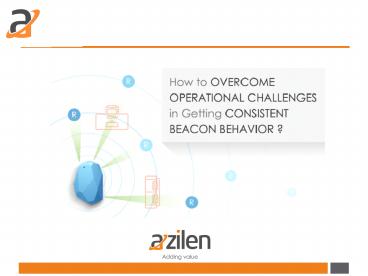How to Overcome Operational Challenges in Getting Consistent Beacon Behavior? - PowerPoint PPT Presentation
Title:
How to Overcome Operational Challenges in Getting Consistent Beacon Behavior?
Description:
This blog is about conquering the operational challenges such as Beacon range detection and signal fluctuation that are encountered while getting the consistent Beacon behavior for Android and iOS mobile devices. – PowerPoint PPT presentation
Number of Views:14
Title: How to Overcome Operational Challenges in Getting Consistent Beacon Behavior?
1
(No Transcript)
2
Intro
- The usage of Beacon is increasingly getting
prevalent especially in segments such as
hospitality and retail to provide special offers
in line with various loyalty programs to its
regular customers and the customers get
notifications about unique offers while they are
in the premises of casino, restaurant, store etc.
The several challenges are likely to be
encountered while utilizing Beacon power at its
best. - Challenge 1 Difference distance detection ranges
for iOS and Andoid - - In the real world scenario, iOS devices and
Android devices have remarkable difference in
their Beacon detection ranges. - Challenge 2 Signal fluctuation
- - The consistency of Beacon signals does rely
upon various factors and hindrance in those
factors may cause the signal fluctuations
eventually affecting the expected outcomes. - - Team Azilen carries out in-depth research to
overcome these challenges and finally came up
with the optimum solution. The challenges and
solutions both are described below with all
relevant details.
3
Challenge 1 Difference distance detection ranges
for iOS and Andoid
- iOS works in accordance with iBeacon protocol
while Android considers Beacon as a Bluetooth
device. Hence, they both react in a different
manner when it comes to detecting Beacon signals. - For example, in general, we can consider that iOS
devices detect Beacon signals at 7 8 meters
whereas Android devices detect Beacon signals at
15 18 meters.
4
(No Transcript)
5
- gt If the Beacon is there at the range of 10
meters, Android device will start receiving the
Beacons signals from about 15 to 18 meters and
it will consider the Beacon IN. - gt On the other hand, iOS device considers the
Beacon IN when the proximity in NEAR. iOS is not
stable to get NEAR proximity at 10 meters and
gives fluctuated or uncertain experiences in
detecting the Beacon. - Solutions
- We had several experiments with Beacons RSSI
function in line with Beacons optimum
calibration.
6
- GUI testing and ease of functionality A robust
and open-source software testing
frameworkSelenium automation framework is used
for this purpose. - Solving execution time issue Selenium automation
framework is integrated with Saucelabs that just
needs the platform configuration for the test
case to run on multiple environments parallel
with other test cases. - Reduced infrastructure cost With the integration
of tools like Selenium and Saucelabs with Jenkins
server, it offers continuous integration of data
for ease in testing.
7
- Beacon Calibration Calibration is a process of
defining the signal strength that the Beacon can
transmit to the receiver mobile device at the
reference point of 1 meter. The first step in our
solution is to calibrate the Beacon as per
requirement. - RSSI Received Signal Strength Indicator is the
strength of the Beacons signal which gets
displayed on the signal receiving device. Android
works complying with RSSI. So we defined ideal
RSSI value after Beacons calibration. We got -97
to -100 dbm at Beacons last spot of range. We
defined separate RSSI for each beacon.
8
(No Transcript)
9
- Consequential Outcomes We could detect beacon at
near about exact (/- 1 to 2 meter variation)
range of its calibrated region for both Android
and iOS platforms.
10
Challenge 2 Signal fluctuation
- Up to some extent, the consistency of Beacon
signals does rely upon several factors such as
surrounding infrastructure as sizeable metal or
wooden article can cause reflections or
attenuations that affect the signal level.
Sometimes, other disruptions occurred or even an
object passing through between the mobile device
and the Beacon can cause signal fluctuation. The
mobile device keeps getting OUT and IN due to
such hindrance.
11
(No Transcript)
12
- Solution
- Beacon IN/OUT cycle The mobile device
continuously receives the signals for each beacon
and update the beacons state as IN/OUT as per
RSSI and IN/OUT threshold. - As discussed earlier we have defined IN/OUT
threshold for each beacon as 8 seconds for IN and
10 seconds for OUT. Therefore, if any object
comes between Beacon and the mobile device
application will start cycle to region OUT and on
the next interval application will get strong
signals so OUT cycle will reset and keep beacon
IN. Thus, based on IN/OUT cycle we could resolve
fluctuation issue.
13
- Conclusion
- Development experiments often make us realize
that sometimes, complex or complicated sounding
challenges can be addressed by very simple
solutions. And this is how with a
straightforward and solution oriented approach,
we could manage to get consistent Beacon behavior
for both Android and iOS even in environment.
14
- Let's Discuss Your Requirement!
- info_at_azilen.com 1-972-325-2243
15
- Original Source
- http//www.azilen.com/blog/overcome-challenges-in-
getting-consistent-beacon-behavior/
16
Thanks You www.azilen.com Let us know if you
have any Question!































